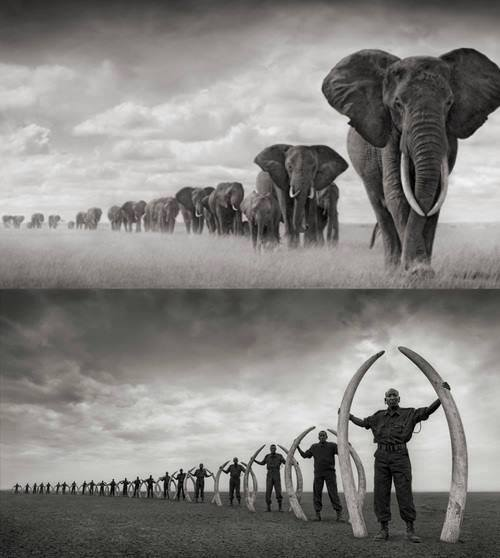Hunted to the Edge: African Elephants Slaughtered

October 14, 2016
“We admire elephants in part because they demonstrate what we consider the finest human traits: empathy, self-awareness, and social intelligence. But the way we treat them puts on display the very worst of human behavior,” (Graydon Carter).
The African elephant population has been decimated on a fearful scale. From 2009 to 2014, over a quarter of a million elephants have been killed. Hunted and mutilated to satisfy the insatiable human desire for one commodity – ivory.
The ivory trade brings in over one billion dollars annually, with the nation of China being the world’s number one demander, and the United States following in second. Ivory is valued for its beauty and durability, it is configured into intricate sculptures by master crafters, and used for more common items, such as chopsticks, hair pins, buttons, combs, and even piano keys.
Often, ivory is used as a currency amongst militia groups, such as the Sudanese military, who take part in the poaching.
Joseph Kony, an African warlord, leads a brutal group known as the LRA or Lord’s Resistance Army; who are responsible for the murders of mothers, the sexual enslavement of young girls, and the training of boys to join their ranks. His group, along with other resistance fighters, cash in on the ivory market in order to support their goals.
CITES, the Convention on International Trade in Endangered Species of Wild Flora and Fauna, placed a ban on the ivory trade in 1989, allowing the elephant population to stabilize after years of unprecedented decline. Despite this, illegal smuggling of the good has continued, and on average, only ten percent of traffickers are caught; those that are face little penalty due to the high levels of corruption found in the government officials of these countries.
When trade with China and Japan was once again legalized, although on a limited scale, the level of poaching skyrocketed. Many anti-poaching rangers have lost their lives in the attempt to save the elephants.
As the population of African elephants is highly matriarchal, with the mothers traveling in herds with their young, a poaching expedition will mainly target them rather than the lone male, upsetting the familial balance and often forcing calfs to wander to unrelated groups.
Elephants have the largest brains of any mammal on the face of the Earth. They are creative, altruistic and kind,” (Ingrid Newkirk).
Studies have shown that elephants are attuned to mortality; when encountering the corpse of another elephant, especially one of which they knew, many will shed tears, refuse to leave its side, or stroke it with their trunk.
With this compassion comes a sense of protectiveness. Herds will travel with the mothers in a circle around the young; and it is often in this very position that the victims of poaching are found posthumous.
It is estimated that in the next ten years, the African elephant will be extinct. The number one solution to this problem requires that the problem must be acknowledged rather than ignored. In order to prevent a future that is otherwise inevitable, the ban on ivory must be reinstated, and the demanders of ivory must become educated on what it truly costs to make a pretty figurine.
“Elephants Quotes.” BrainyQuote. Xplore, n.d. Web. 10 Oct. 2016.
Scriber, Brad. “100,000 Elephants Killed by Poachers in Just Three Years, Landmark Analysis Finds.” National Geographic. National Geographic Society, 18 Aug. 2014. Web. 10 Oct. 2016.
“Threats to African Elephants.” WWF Conserves Our Planet, Habitats, & Species like the Panda & Tiger. WWF Global, n.d. Web. 10 Oct. 2016.